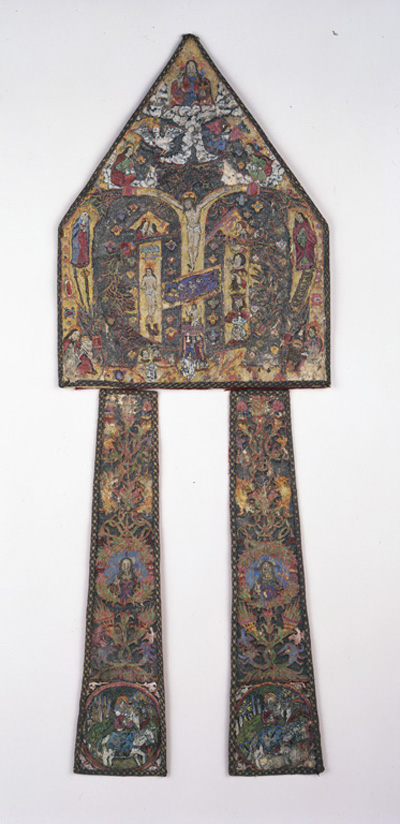Bishop's Featherwork Miter
ca. 1559-66
Michoacán (Mexico)
Feather mosaic on amatl
31.7 x 41.5 cm
Of the seven known surviving featherwork miters found today in church treasuries and museums, this is the only one in the Americas. Dating from the sixteenth century, these works represent the peak of Amantecayotl, or feather mosaics, an art form highly valued in pre-Conquest Mexico, where it was employed for clothing, headgear, fans, and shields. Cortés sent several to Charles V and soon European kings and aristocrats came to prize these pieces. Such was their fascination that Fray Bernardino de Sahagún (Historia general de las casas de Nueva España) and other chroniclers have provided invaluable information on the technique: how iridescent feathers from hummingbirds and other native birds were carefully trimmed and applied in layers using an orchid-based glue onto amatl or maguey paper. With the arrival of the Spanish, missionaries oversaw the production of featherwork for Christian use at convent schools, but with the images now based on European prints.
The Society's miter and infulae (not shown) offer an exceptional example of such an object, showing in particular, how the layering of the feathers permits a striking range of colors and delicate forms. On each side of the miter, the Crucifixion appears with a golden background while the curved cross arms terminate in foliage under which stand the Virgin Mary and John the Evangelist. Other scenes on the miter include the Mass of St. Gregory, Christ in Glory and the four Evangelists with their symbols. An almost identical miter (today in Milan) was a gift to Pope Paul IV (I559-66).
Text and images © Hispanic Society of America.
